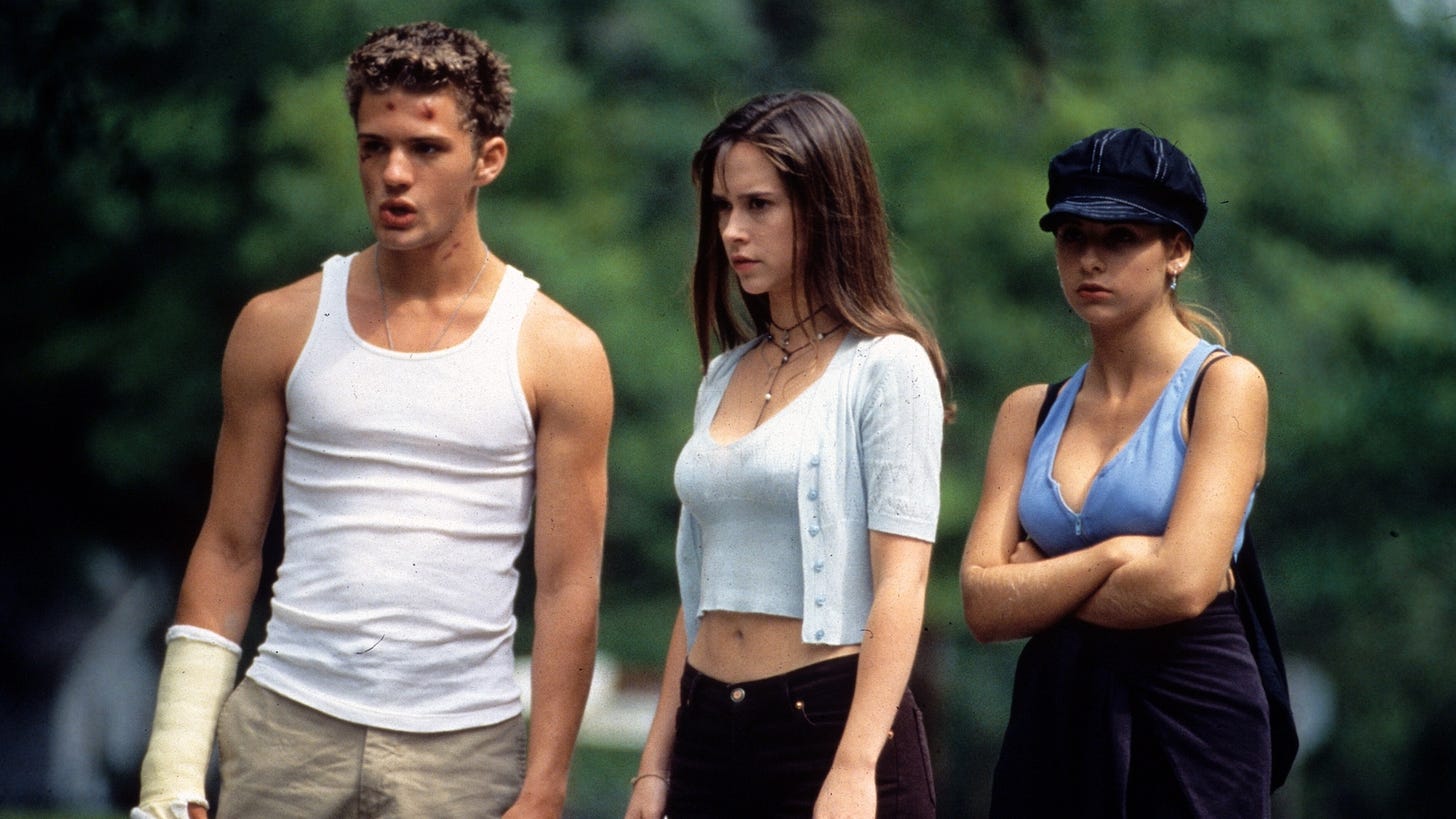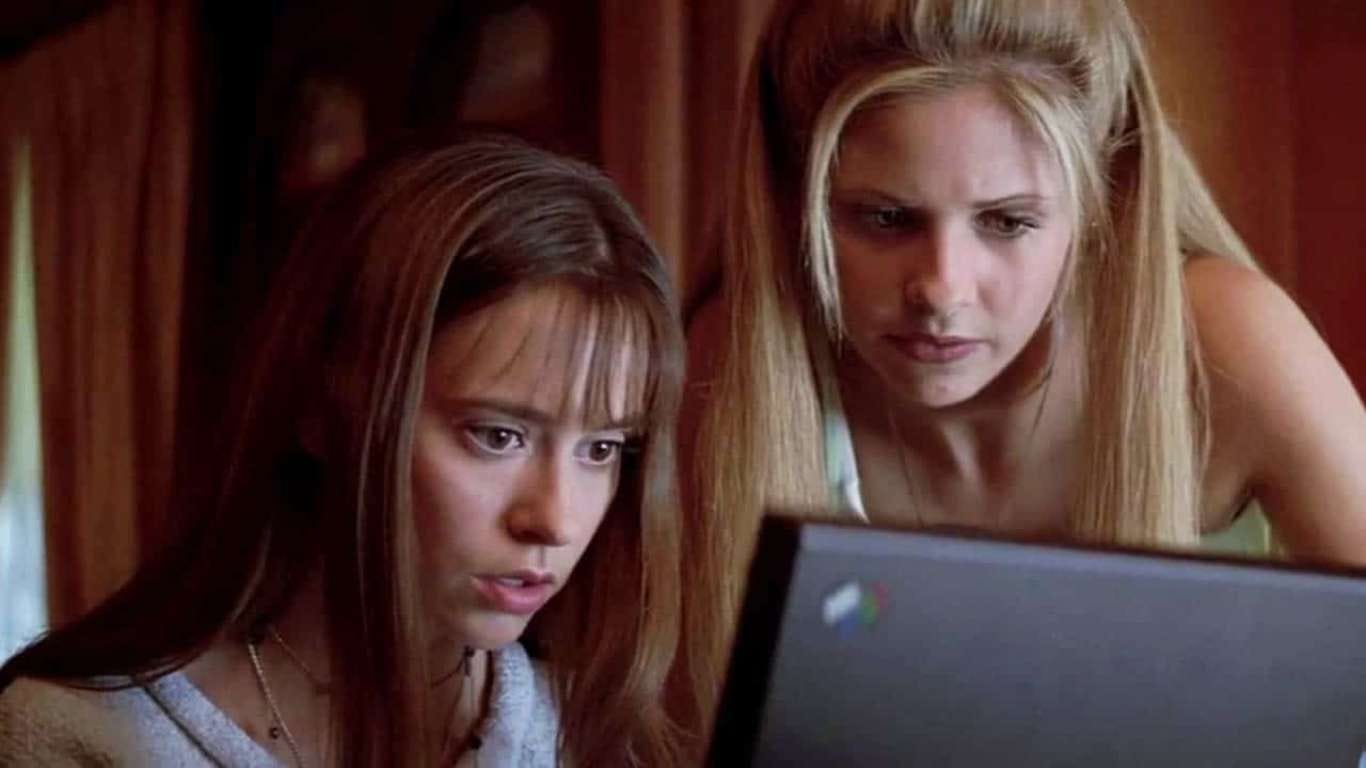'I Know What You Did Last Summer': The Rise and Immediate Fall of the Neo-Slasher
A year after 'Scream" revived slashers, another Kevin Williamson hit show signs of diminishing returns.
“We never killed anyone.” — Jennifer Love-Hewitt, I Know What You Did Last Summer
The celebrated opening sequence of the original Scream establishes, in chillingly effective terms, the cake-and-eat-it-too strategy that allows the film to deconstruct the horror genre while still delivering the goods. Step One to this strategy: Hire Wes Craven to direct. When the killer we’ll later know as “Ghostface” puts in a call to Casey Becker (Drew Barrymore), the archetypal teenage-girl-alone-in-the-house, the horror references commence, with a nod to Craven’s A Nightmare on Elm Street and a consequential round of movie trivia. But the Craven film the sequence calls most powerfully to mind is 1972’s Last House on the Left, an exercise in horror realism that strips away the atmospheric trappings of the genre until all that remains is raw desperation. Two teenage girls fight for their lives. Then the parents of one fight for theirs, too.
That opening isn’t merely a bravura bit of throat-clearing on Craven’s part, but a reminder of what such a brutal death really looks like: the panic, the struggle, the will to survive, the body clinging to life. And as with Last House on the Left, the parents have a role to play, too, coming home first to realize that there’s been a violent intruder before finding their mutilated daughter in a ghastly display. Craven hits the audience unusually hard with Casey’s death—Scream is a hard-R for its violence, which is one of the many things that separate it from its sequels and imitators—because it will serve his purposes later. When the action settles on Sidney Prescott (Neve Campbell), a young woman still reeling from her mother’s rape and murder, Craven wants us to contrast her trauma with the utter detachment of her classmates. That’s the hidden concern of Scream: We may get knowing laughs out of scenes like the one where Jamie Kennedy breaks down the “rules” of horror films like Halloween, but meanwhile, people are getting slaughtered in chaotic and messy ways.
The Reveal is a reader-supported newsletter dedicated to bringing you great essays, reviews and conversation about movies (and a little TV). While both free and paid subscriptions are available, please consider a paid subscription to support our long-term sustainability.
The lessons of Scream were not carried forward—not by the hacks behind the “neo-slasher” boom, nor by Craven, who directed three sequels, or screenwriter Kevin Williamson, who became a white-hot film and TV creator in Hollywood. It could be one of Jamie Kennedy’s “rules”: Follow-ups to horror phenomena like Halloween and Scream are doomed to yield diminishing returns, if not lose the plot altogether. What Craven and Williamson pulled off in Scream was unsustainable, because the horror and comedy elements are so difficult to hold in balance without diminishing the other. In no time at all, Scream’s self-awareness hilarity turned into a sprinkling of know-it-all smugness, and its visceral punch was softened into jump scares and slick, metronomic kills-for-kids, eventually bloodless enough to pick up PG-13 ratings.
I Know What You Did Last Summer, adapted by Williamson from Lois Duncan’s YA novel and directed by Jim Gillespie, arrived less than a year after Scream, and all the compromises to come were on full display. Like a lot of bad ’90s popular art, the film has enjoyed a weird reclassification as a genre classic, which made me wonder if I’d been mistaken in finding it mediocre at the time. I was not. (I was similarly not mistaken in finding Counting Crows’ August and Everything After mediocre, but that’s a discussion for another Substack.) It is the best possible version of the bad movies that would follow Scream, however, and worth revisiting to see that point of departure where Williamson and the entire neo-slasher movement would go astray. In style and ambition, the film has just enough in common with Scream to make its flaws really pop in contrast.
Released a couple of months before Scream 2, I Know What You Did Last Summer was primed to capitalize on Scream’s success, not only with the Williamson script, but with a big, marketable (and, it should be said, literal) hook of a premise and a cast of young stars on the rise. Of the four leads, only Jennifer Love Hewitt had established herself with the FOX drama Party of Five, and Sarah Michelle Gellar was just getting started with Buffy the Vampire Slayer. The guys were more or less unknowns, with Ryan Phillippe appearing as one of a dozen teenage hotbodies in Ridley Scott’s sailing thriller White Squall and Freddie Prinze Jr. popping up in a minor role in the Sundance comedy House of Yes. The film offered them the chance to do what up-and-coming young Hollywood stars do best: Look great and get murdered.
Yet there’s an important thematic tissue connecting Scream with I Know What You Did Last Summer: Both are about a teenage girl dealing with a lingering trauma as the people around her insist that it’s no big deal. The Sidney Prescott type here is Julie James (Hewitt), a graduating senior from a small seaside town in North Carolina who’s celebrating the Fourth of July with friends who will all go their separate ways come fall. As with Sidney, Julie is virgin-adjacent, near enough to her virginity to where she can play the innocent Final Girl type, but not enough to where she embodies the cliché. Shortly after giving it up to humble boyfriend Ray (Prinze Jr) on the beach, Julie joins her drunk friends, beauty queen Helen Shivers (Gellar) and rich jerk Barry (Phillippe), in peeling off down a curvy cliffside road, with Ray serving as designated driver. Despite this precaution, a distracted Ray hits someone on the road and that person seems to be dead—at least by the rushed pulse-check standard of these non-doctors.
The four face a dilemma: They could summon the police, leading to vehicular manslaughter charges that could derail their plans for the fall. Or they could roll the body into the ocean and let the tides do their work. They choose the second option, over Julie’s strenuous objections—and against the moral logic of MovieLand, where injustice is rarely meted out as cruelly as arbitrarily as in the real world. When she returns the following summer to the ominous note of the title, and people start dying at the hands of a hook-wielding madman, Julie’s original objections give her a kind of invisible armor. She and her now-estranged friends must reunite to figure out who wrote the note and who’s been doing all the killing. They assume it’s the same guy, which is a subtle indicator of the film’s moral dissonance: Why would they (or us) believe the person they ran over with their car is also a serial murderer?
Because it would let them off the (again, literal) hook, that’s why. For whatever substance it can claim to have, I Know What You Did Last Summer puts a heavy emphasis on the crippling guilt Julie carries and how it contrasts with Ray (who feels pretty guilty), Helen (a little guilty), and Barry (not guilty in the least). (The level of guilt is also the order of slash-ability.) Opening with a doom-y goth-rock cover of Seals & Croft’s hit “Summer Breeze”—summer breeze does not make the teenagers of this seaport feel fine, you see—the film is an easy-listening juggernaut for horror mavens, superficially edgy but totally palatable. Gillespie isn’t Wes Craven by any means, but he’s a better-than-average craftsman who’s schooled enough to rip off both Blow Out and Cape Fear in the grand finale.
As for Williamson, who would create another teen phenomenon with Dawson’s Creek a year later, he doesn’t allow the audience to stay mired in a moral quandary for long. By the time his byzantine plot mechanics work themselves out, Julie and whatever friends survive no longer have to worry about the toll that running a man over and dumping him the sea might take on their conscience. It’s all very simple: The dead man they thought they killed was actually the boyfriend of the daughter of the victim. The victim had killed the boyfriend that same night, because he blamed the boyfriend for his daughter’s death in an earlier accident. The twist in I Know What You Did Last Summer is that Julie never had to sweat her role in abetting vehicular manslaughter, because, as she concludes, “We never killed anyone.” Retroactively, we might even consider these teens heroes for trying to stop this vengeful maniac before he kills again!
As the neo-slasher boom continued into the late ‘90s and early ‘00s, these thin feints at substance disappeared entirely, replaced by cheap shock effects and slightly tongue-in-cheek renderings of the old slasher formula. (For evidence, look no further than I Still Know What You Did Last Summer, which uses a phony radio contest to trap Julie and friends in an empty Bahamian resort off-season. Or near-empty: Among the few locals is a Rastafarian Jack Black.) All horror trends are perhaps destined for the creative graveyard, but never was the descent into mediocrity and beyond as swift as with the neo-slasher—not with the original slashers, not with J-horror, not with found-footage. Williamson and his imitators weren’t as clever as they seemed to believe.






I had forgotten many things about this movie since 1997, but I will never forget my screening of it. I saw it with my grad-school friends at CocoWalk in Miami. Sold out show. Down the row from us, a thirtysomething guy was seeing the film alone in the aisle seat. With every scare or jump scale, he would shriek in terror. And it wasn't some troll, either. It was his genuine reaction. Then, if you'll recall, the film ends in a huge jump scare before the credits roll: He shrieks one last time, stands up immediately and vacates the theater—all in one motion. It was incredible.
One could argue that although the film lets the characters off the moral (but again, not literal) hook with the final revelation that they non-fatally hit Ben Willis instead of whatshisname, there's still a layered irony in that if they had listened to Julie at the beginning and called the police, there's a decent-ish chance their examination & questioning of Willis MIGHT have led to the revelation that he'd just murdered his poor whatshisname, and sent him to jail. It almost certainly would have saved half the group (and a couple of their antagonistic relations) from being murdered, since Willis wouldn't have had nearly as much to be vengeful about.